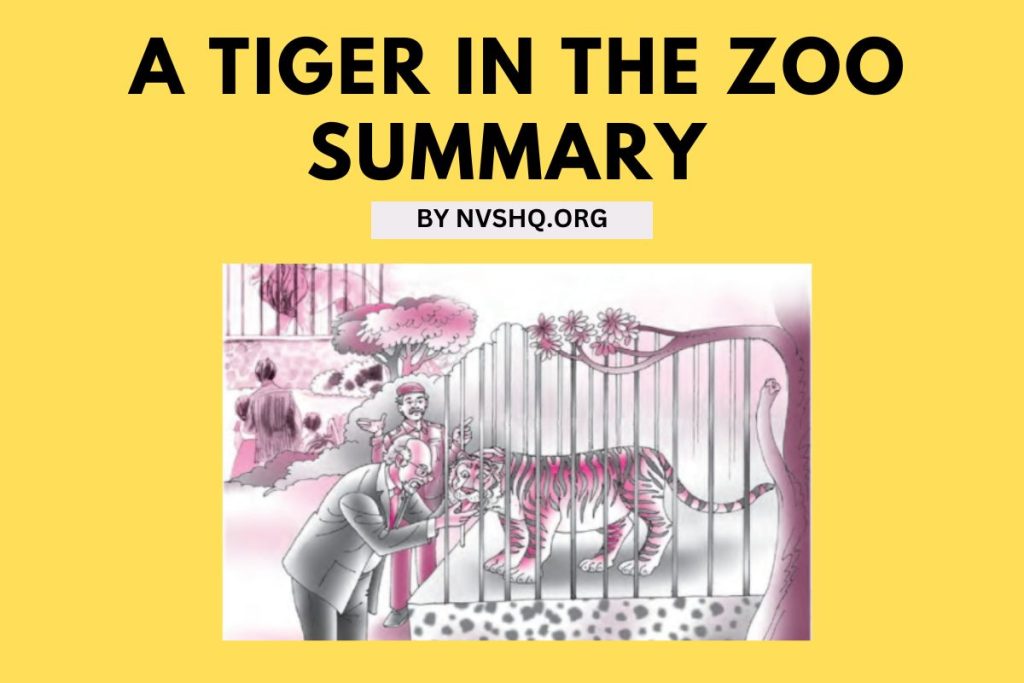A Tiger in the Zoo Summary Class 10 English: In this article, we have provided the summary of A Tiger In The Zoo Class 10 English

A Tiger in the Zoo Summary
“A Tiger in the Zoo” is a poem by Leslie Norris that explores the theme of captivity and freedom through the metaphor of a tiger which is held in a zoo in a cage. The poem highlights the contrast between the majestic, wild nature of the tiger and its captive existence in the zoo. The poet has presented a contrast between a tiger who is being held in a cage in captivity while to the image of the tiger who is free and roaming according to his own will.
The poem describes the tiger pacing restlessly in its cage, held captive inside a cage who is longing for the freedom of its natural habitat in the jungle. The poet observes the tiger’s beauty by giving a description of the beautiful stripes of the tiger and his power by giving us a description of the walking of the tiger quietly filled with rage inside his cage. But simultaneously the poet also feels a sense of sadness for its confinement.
The poem opens with the image of a majestic tiger pacing back and forth in his enclosure, seemingly trapped and powerless. The big strong cage is holding back the majestic tiger. The poet notes that the tiger once roamed the jungle, but now he is confined to a small space, his freedom stripped away. In the first stanza, the poet is describing the tiger who is held in a zoo. He has presented a metaphor of “pads of velvet” to “quite a rage”.
The tiger although sitting quite he is filled with rage because he is held captive inside a cage. The poet has used personification by using the term “he” for the tiger. The poet says that the tiger should be roaming in a jungle and lurking beside long grasses near a water source where it prays the deer should be drinking water.
The second stanza describes the tiger in his natural habitat which is the jungle where a tiger is roaming freely hunting its prey and drinking water. The majestic beast should be roaming around the edge of the jungle where the village starts and terrorising the people living there with its white fangs and claws. The image presents us with a sad reality that how human beings are destroying the natural habitat of other animals for their own establishment.
People are cutting down trees by expanding their own area by reducing the area of other creatures. The tiger is obvious to come close to the houses but not to eat them but just to build fear in them. This is his way of showing his anger towards the humans.
In the third stanza, the poet represents the tiger again in the zoo. The poet is saying that all the strength of a tiger is being locked up inside a cage. The tiger has locked up in a cage a concrete cell or a prison. His strength and capabilities are all locked up beside that bar and he is roaming around in that cage ignoring its visitors who have come up there to see him as a spectacle.
The tiger is roaming in anger inside the cave because of the confinement of his area. He notes that visitors to the zoo stare at the tiger, but they do not see him. They do not see the suffering that comes with captivity or the loss of dignity that the tiger must endure. Instead, they see a mere spectacle, a thing to be looked at and admired.
The poet in the last paragraph describes how the tiger listens to the last voices of night and with its brilliant eyes sees the brilliant stars of the night. The poet has presented us with the loneliness of the tiger. The readers are empathetic towards the tiger now. The tiger has yet not lost hope and when the lights of the patrol vehicle shine in the eyes of the tiger he sees and stares at the brilliant stars. Maybe the tiger feels at home when he sees the stars in the night. The tiger is very gloomy in the end. The poem ends with a powerful message that despite the tiger’s physical captivity, its spirit remains wild and free.
Conclusion of A Tiger in the Zoo Summary
Through this poem, Norris highlights the importance of preserving the natural habitats of wild animals and allowing them to live and thrive in their own environment. The poet sends a strong message of why we humans should not hold back the wild spirit animal and confined them to a small cage. The poem is a Powerful one and forces us as humans to think about what we doing with wildlife. It reminds us that how we are destroying the home of others to build our very own.






